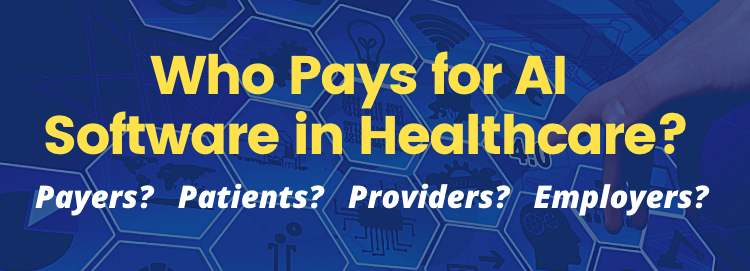
The answer is … it’s complicated.
It depends on what the software does and the benefits of using the software. There are many uses for AI enabled software outside of directly treating patients, including inventory management, nurse scheduling, research, drug discovery — and that’s just to name a few applications. It is clear who pays for those types of software programs: pharma will pay for drug discovery, hospital operations will pay for nurse scheduling, and academia or large corporates might pay for research. In this series, we’re covering FDA cleared and/or HIPAA compliant software that is used directly in patient care — and that’s what makes “Who Pays for AI Software” a tricky question.
CMS, the Center for Medicare and Medicaid, is the organization that sets the standard of care in the US healthcare industry. As CMS goes, the industry follows. CMS is already reimbursing hospitals, clinics and physician practices for some AI based software applications that they use for individual patient care.
One example is a company in the neuro-stroke space called Viz.ai. FDA cleared Viz.ai can be used to quickly detect a specific type of costly and highly damaging stroke called large vessel occlusion (LVO) strokes. This is now reimbursed by CMS for $1,040 when used in the ER to help diagnose suspected LVO cases. The reason? It has been shown to improve patient outcomes by catching LVO strokes earlier than without the software. When dealing with an LVO stroke, those few minutes count — and AI software like Viz.ai can be the difference between life and death.
As discussed in a previous installment, BrainCheck’s AI enabled software for neurology is reimbursed by CMS for their electronic dementia screening when used under the care of a healthcare provider. BrainCheck’s cognitive care platform is separately reimbursed by CMS to monitor dementia patients over time. Since BrainCheck enables the dementia screening to be shifted from a neurology clinic to the primary care office, it creates a new revenue stream for primary care docs — and most importantly, can have a positive impact for individual patients.
About 30% of dementia cases are preventable, but most of us don’t go to a specialist clinic like neurology until something is impeding our daily lives. At that point, dementia can be too far advanced for pharmaceutical intervention and lifestyle behavior modification to make an impact on the disease progression. In the US, there are less than 14,000 neurologists, but over 250,000 primary care docs. Screening and monitoring for dementia at a patient’s annual physical instead of a specialist’s office can improve patient outcomes. When dementia is caught early, it is treatable.
Digital Therapeutics companies (DTx) like Omada and Livongo that focus on managing chronic conditions are typically paid for by the employer or health plan, with zero cost for the patient. Large employers spend a significant amount of money for their employees’ health, and not just in insurance premiums. Employers know that by helping their employees manage their health conditions through employee wellness, they can reduce healthcare costs while improving employee productivity. Major health plans also know that helping patients manage expensive chronic conditions like diabetes can result in lower costs for treating that patient. As discussed in the 2nd installment on Digital Therapeutics (DTx)— any type of disease or condition that has a behavioral component — such as diabetes or hypertension — is a good candidate for DTx and employee wellness programs.
While AI software like Pear Therapeutics’ FDA cleared DTx apps for opioid addiction, insomnia and substance abuse are not currently reimbursable by the major payers, that is the goal. Their newly launched app for insomnia is available for cash-pay patients for $899. While that is not an accessible price for an app for all patients, Pear Therapeutics is currently giving discounts, and the app can be paid for using HSA/FSA accounts. It’s useful to remember that pharmaceutical drugs, especially new meds without generic competition, can cost that much or significantly more without insurance. While software does have a cost to run, unlike hardware or physical goods like pills, software can scale quickly, easily, and with significantly less money than a physical product. While in the US the cost of a DTx like Pear Therapeutics’s cash-pay price tag may not come down due to the way healthcare is reimbursed, the incremental cost of delivering an app to a patient is negligible.
Business and profits aside, DTx can help democratize healthcare in a way physical products can’t — by giving easy access to anyone with a connected smartphone or smart tablet, no matter where they live.
Pear raised $80M at the end of 2020, bringing their total funding to $214M. This new capital raise is specifically to work on accelerating the reimbursement process for digital therapeutics. Pear recently published data from a research study using their FDA cleared app reSET-O for opioid use disorder (OUD), which showed the DTx reduced healthcare spending by $2,150 per patient.
